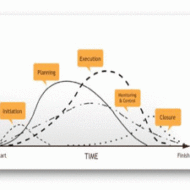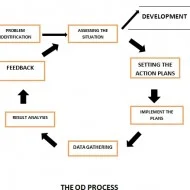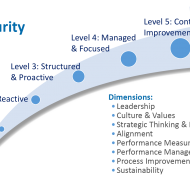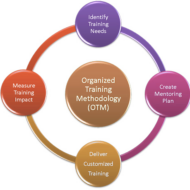Posted by Managementguru in Business Management, Decision Making, Marketing, Operations Management, Project Management
on May 7th, 2014 | 0 comments

Project Formulation and Project Life Cycle What is a Project? “A temporary endevour leading to a product / service or result ” A project is any series of activities and tasks that: • Have a specific objective to be completed within certain specifications • Have defined start and end dates; • Have funding limits (if applicable); and • Consume resources (i.e. money, time, equipment). Characteristic Features of a Project: • Has a mission or a set of objectives. Once the mission is achieved the project is treated as completed. • Has to terminate at some time or the other (temporary in nature) • The project is one single entity and its responsibility is assigned to one single agency. • Calls for team-work, the members of the team may come from different organizational units, different disciplines, and geographic regions. • Has a life cycle represented by growth, maturity and decay. • Is unique and no two projects are similar, even though the plants set up are identical. The organizations, the infrastructure, the location and the people make the project unique. • Change is a natural phenomenon with every project throughout its life span. Some changes may not have any major impact, but some may change the very nature of the project. • The happenings during the life cycle of a project are not fully known at any stage. As time passes, the details are finalized successively. • Is always customer-specific. The requirements and constraints within which a project must be executed are stipulated by the customer. • Is a complex set of things. Projects vary in terms of technology, equipment and materials, machinery and people, work ethics and organizational culture. • A substantial portion of the work in a project is done by sub-contracting. The greater the complexity of a project, the greater will be the extent of work performed by subcontractors. • Is exposed to risk and uncertainty and the extent of these depend upon how the project moves through the various stages in its life span. • A well defined project has lesser risk and uncertainty, whereas an ill-defined project faces greater degree of risk and uncertainty. Project Life Cycle: The Project Life Cycle refers to a series of activities which are necessary to fulfill project goals or objectives. The different phases are as follows: a) Concept or initialization phase In this phase, the project idea emerges and the #management decides on the need for a project. A project which is well conceived can be later implemented successfully. b) Project Definition Phase •The techno-economic viability of the project is checked •The technical configuration of the project is identified •The performance requirements, sub-systems, key equipments etc.- purchased •The cost estimates with limits are identified •Schedule of implementation is identified c) Growth or Organisation Phase Organizations, during this phase, undertake the following actions: a) Establishing the infrastructure and enabling services for the project b) Project engineering and design c) Setting up Project Organization and staffing d) Appointing a project manager e) Preparing schedules and budgets f) Obtaining necessary licenses and clearances from the Government g) Raising finance h) Developing systems and procedures for monitoring and reviewing project progress i) Procedures for inviting tenders and awarding contracts j) Site preparation and development k) Procuring equipment and materials l) Work packaging This phase covers both paper work connected with project planning and also implementation activities. Planning is necessary to avoid crisis management; it makes the implementation phase to run smoothly. d) Implementation Phase The activities include: 1) The preparation of specifications for major equipment and machineries, 2) Placing orders with vendors for the supply of...

Posted by Managementguru in Business Management, Change management, Human Resource, Organisational behaviour
on Mar 30th, 2014 | 0 comments

Integrated Organizational Development Organizational Development : in short OD, is a systematic, integrated and planned approach to improving enterprise effectiveness. Corporate firms can achieve success only when the available #resources are put to optimal use. Optimisation implies, deriving the best out of the limited or scarce resources. A firm is comprised of many departments, all of which compete for the same kind of resources and it becomes a tough proposition for the #management to allocate the resources suitably to different cost and #responsibility centers. The point is, changing needs of an organization has to be keenly observed by the management and if it senses a need for organizational development in any one of the disciplines, it should immediately employ appropriate #interventions to improve the #performance and #productivity. Culture – The Fundamental Aspect: Organizational development involves a paradigm shift in its culture, which is the fundamental aspect. It does not just mean finding solutions to problems. It is a process of managing change in an organization, resulting in behavioral changes in #employees for the good of the organization. Firms adopt different interventions to bring in changes in the behavior of employees through learning. The aim of introducing interventions would be to meet the short term and long term #objectives of the firm in an integrated fashion. Only when the employees are suitably appraised about the objectives and trained accordingly, their mindset gets tuned in to perform as per the expected standards. Intervention Techniques: Intervention techniques focus on shifting the individual’s focus from “me” to “us.” Before delving into the types of interventions, one might wonder why an organization needs to incorporate such interventions at the first place. The reasons may be attributed to the following: Some kinds of problems keep recurring to the surface. Even after solving a particular problem, another one of similar nature erupts. Productivity improvement techniques are not effective. Any amount of effort fails to yield the desired result. Employee morale is low and the top management is unable to pinpoint any particular reason for the undesired development. How to Overcome #Resistance from Employees’ End? Intervention techniques encourage employees to come out with suggestions and take part in decision making as well for the betterment of the organization. Though initially there might be a resistance to change, as it is natural for humans to resist change, gradually the workforce understands the importance of initializing the change that might have a direct bearing on them and their working environment. A holistic change is what is needed for an organization to rise as a whole to greater heights. #Group Training: Group training is a vehicle for individual change. It improves the listening skills, empathy, capability of being sensitive to fellow workers’ needs, interpersonal skills, and desired behavior in a social setup etc., Trainees selects the problem issues that are of interest to them, the setting being informal and unstructured and most interestingly there is no external force to structure the discussion. But it may be noted that the trainer interferes in extreme cases where the discussions turns out to be #counterproductive and destructive. #Survey Feedback: Survey feedback is another kind of intervention that gathers data from employees at different levels regarding the problem issues, through questionnaires and the feedback of the survey is analyzed by the top management to find the loopholes or bottlenecks hindering the development. This has been a popular organization development technique since time immemorial and still followed suit. These programs are useful in improving the #quality of work life and employee productivity. Analysis of the effectiveness of intervention programmes and evolving right research designs to measure the variables before and after the change, shall reveal the...

Posted by Managementguru in Business Management, Decision Making, Organisational behaviour, Principles of Management, Strategy
on Mar 24th, 2014 | 0 comments

STRATEGIC PLANNING Strategic planning is the primary step in the process of strategic management [Strategic management is a comprehensive topic that covers almost all the functional aspects of the organization] which can be outlined from at least two perspectives: First, strategy is the “broad programme for defining and achieving the objectives of an organization and implementing its mission”. Secondly, “It is the pattern of the organization’s response to the external environment over a period of time”. A strategy that takes a broad and typically long range focus is called strategic planning. MBA Application Strategies for Top Business Schools Strategic planning is the process that classifies the long range goals of the organization and opts for the precise means (strategies and polices) for achieving these goals, allocates resources, and develops long range plans to reach the destination. Watch this Video to Understand the Overview of Strategic Planning Process Time-Horizon: Strategic planning takes into account the extended time horizon. There may not be any immediate impact out of strategic planning, but the consequences in the long-run prove to be gradual and significant as well. It provides with the necessary action plans to make a difference in vital areas concerning development. You can always associate innovativeness with strategy since it explores new paradigms and tries to enhance the impact. When the size of organizations expands, they are broken down into strategic business units (SBU’S) for the purpose of functional excellence. These units are expected to operate as if they were relatively independent businesses. WHY STRATEGIC LEADERSHIP IS IMPORTANT A Tailor Made Approach: A tailor made approach is essential when it comes to strategy development the systematic analysis of the factors associated with customers and competitors (the external environment) helps the organization to meet the challenges of modern society. More and more organizations are focusing on formal approaches and concepts for planning their long range process. Specifically these challenges are a result of increasing rate of change, the complexity of manager’s jobs, the increasing importance of fitting the organization into external environment, and the increasing lag between the preparation of plans and their implementation in future. Resource Allocation: Strategic planning is an organization’s process of defining its strategy or course, and making decisions on resource allocations to pursue this strategy. Managers must be adequately geared up for strategic planning. The goals of the organization must be made plain and not unclear. Each business unit should be categorized based on its performance level to decide on the resource share to be allocated. You need to infuse cash flow into ineffectual units and divest funds from dying units into other profitable ones. The ultimate aim is to build up star performers that will be the perennial source of income or revenue generation. There should be a strong linkage between planning and control. The assessment of strategic plans of the business units must be made periodically and effectively. TOP FIVE REASONS WHY STRATEGIC PLANS FAIL SWOT Analysis: SWOT analysis is a strategic planning technique used to evaluate the Strengths, Weaknesses/Limitations, Opportunities, and Threats. Planning is the primary step for control as it provides several standards and benchmarks of control. Planning extracts commitment. Some times planning highlights the objectives only and the planning premises may not be fully reliable. Threats are to be considered as challenges and must be converted into opportunities. Two heads are better than one is the philosophy of brain storming where a group of people with knowledge and expertise assemble to lay out clear plans that will steer the organization smoothly even in times of rough...

Posted by Managementguru in Business Management, Human Resource, Organisational behaviour, Principles of Management, Training & Development
on Mar 22nd, 2014 | 0 comments

Crucial Aspects of a Successful Training Plan Training should be aimed at improving the individual’s skill set as well mind set to gain knowledge about the work environment he will be exposed to, as well as to exhibit the right kind of attitude and behavior towards his peers and superiors. What is the need to train people? It is like molding raw clay into the desired shape and structure to suit our needs. An untrained individual, how well qualified he may be cannot fill the bill. Pros and Cons of Training: Corporate training methods include cognitive as well as behavioral type of training. But the crux of the whole thing is that the trainer must keep in mind the trainee’s present skill set or background and to train him in areas where he lacks verve. Also the pros and cons of each and every method should be analysed before training is imparted. Cognitive training is to theoretically teach trainees the concept of work and how to go about it. This is equally important as learning induces changes in behavior of individuals. Virtual Reality Training: Virtual reality training method is gaining momentum in areas of medicine, engineering and aeronautics where the trainee is exposed to situations artificially recreated for the purpose of simulation. Introduction to QuickBooks 2017 The trainee is benefited by the near perfect exposure he gets through these types of training methods. Simulations in the field of medicine are a real boon to students doing their internship and also to the surgeons performing complicated surgeries. On the job training: On the job training makes the trainees incorporate conceptual learning to be put into effective use. The experience adds value to their career and it is a good way to grow. The trainee also has to understand the significance of being trained that gives him an edge over others. Business games are popular in corporate setup where the members of a team are asked to don different roles or positions of the firm and solve a particular problem situation. This develops sound reasoning skills and instills confidence to handle crisis situations. Concept of training: The very concept of training is to make the individual tailor made for the job he is about to perform; not only the physical aspects but also psychological and social aspects have to be included in the package that will etch a comprehensive pattern in the process of management development techniques. Training improves the effectiveness and efficiency of performance, oriented towards goal setting, develops inter personal relationship and helps in the exercise of knowledge building providing room for improvement. Soft skill training: Soft skill training is a must as communication is the most important aspect that binds any organization for the purpose of delegation, clarification and development. Trainers have to be suitably trained and the common objective for both trainers and trainees would be to satisfy the objectives of the organization and work towards it. Evaluation of training gives you an idea whether your training design has been successful and the implementation satisfactory. Employee Feedback: Feedback from the employees and the ratio of performance standard achieved against the established standards sets the benchmark for the next mile of achievement to be covered. Blogging and Podcasting for Beginners Workshops, seminars, lectures, discussions aid not only the trainees but also the employers of the company to periodically refresh themselves with the ongoing changes and developments in the industry. The bottom line is, training has to bring in not only transitions but also transformations in individuals in terms of improved personality, attitude, behavior and adaptability to better their future...

Posted by Managementguru in Business Management, Decision Making, Principles of Management
on Mar 6th, 2014 | 0 comments

A Process of Intelligence Effective Decision making is a process of Intelligence, Design and choice activities and “is a central part of the management process”. Decisions are hard to make but once decided there should be no second take. The following steps are involved in the process of Decision-making: 1. Recognizing the problem 2. Deciding priorities among problems 3. Diagnosing the problem 4. Developing alternative courses of action 5. Evaluating alternatives 6. Selecting the best alternative 7. Effective implementation and follow-up action. Recognizing the Problem– Herbert A Simon calls this step as an “intelligent activity“. It is important to find out whether there is any deviation from the past experience. For e.g. Sales might decrease, expense might decrease, sometimes there might be deviations from the plan, sales budget, and competitors may outperform by improved systems. Deciding priorities among the problems: A manager would face many problems at the same time. He should not be bogged down with small and unimportant problems. Some problems can be easily solved by the sub-ordinates. Some may not be important. A manager must see that – he selects carefully the most important problem. Peter Drucker says that “once the right problem is perceived then half of the problem is solved”. A manager must diagnose carefully by asking the following questions. a. What is the real problem? b. What are the causes and effects of the problem? c. Is this problem very important? d. Can they be solved by sub-ordinates? e. Which is the right and most important problem to be solved? Diagnosing the Problem: After choosing the right problem the manager must now start diagnosing the problem. There is no simple answer to the question of how to diagnose the problem, because every individual differs in his or her own way of diagnosing the problem depending on the different background orientations and training. A manager must systematically analyze the problem for identifying the alternative causes of action. Developing Alternative Courses of Action: This step is creative and innovative where a manager analyzes from all perspectives Sometimes a manager can also use a technique called “brainstorming” where a few individuals discuss at length the various possible available alternatives. First of all, a manager must be thoroughly familiar with the problem. This is called saturation. Later, he must think about the problem from several view-points which is called deliberation. Sometimes the manager may not get into the crux of the problem, i.e. there may not be any fruitful result of deliberation, and then the manager might temporarily switch off his conscious search and relax. This process of realization is called incubation. Then after sometime, a flash of light may occur, and the manager may get some insights and ideas. This stage is called illumination. In the last stage, which is called accommodation, the manager resynthesises his ideas into a usable proposal. Evaluating the Alternatives: The manager must now give proper weightage to the positive and negative aspects of the alternatives and evaluate by using some criteria like (a) time; (b) cost; (c) risk; (d) results expected; (e) deviations anticipated; (f) resources available for implementation. Selecting the Best Alternative: This is the most important step where the manager selects the best alternative that will yield maximum profits or results with minimum cost, input or resources. To put it in simple terms, the solution should be able to solve the problem in the best possible way. Effective Implementation and Follow-up Action: Any decision without proper implementation becomes futile and hence proper care must be taken by the manager to pool resources and start implementing the decision taken. In large organizations, follow-up procedures are available in the system...










